Top 10 Apps for Bullet Journal
Explore the best apps for bullet journal to boost productivity and streamline tasks with options like NotePlan, Trello and more.

I've spent countless hours trying out different digital journaling tools. However, finding that perfect software to suit your needs isn't always straightforward. With so many options available, how do you know which one is the best fit for you?
I've evaluated a series of bullet journaling software like NotePlan, Trello, Taskade, The Bullet Journal Companion 2, Dynalist, Elisi, Journey, Day One, Grid Diary, OneNote, and Evernote. My goal? Help you zero in on the platform that will not only meet, but exceed, your productivity goals. We'll do deep into the key features, pitting the pros against the cons so you can make an informed decision.
"Bullet journaling is not just about keeping a record. It's about making a plan, giving every task a home, and ensuring you're not forgetting anything. It's a productivity tool, a memory tool, a creativity tool - all wrapped up into one. Going digital with bullet journaling can take this experience to a whole new level."
Before going further, let's understanding briefly what this innovative method entails.
What is Bullet Journaling?
The Bullet Journal method was developed by Ryder Carroll to develop “a system flexible enough to handle whatever I threw at it, and fast enough that it wouldn’t get in the way.” The goal was to use a single physical system to keep the past, present, and future organized. A Bullet Journal uses pen and paper: everything lives inside a notebook. To get started, you manually structure your notebook into different sections:
- An Index: a table of contents
- A Future Log: a spread that shows the next 6 to 12 months
- A Monthly Log: a spread of every day in a month on the left and space for tasks you need to complete that month on the right
- A Daily Log: a running list of days with specific entries: tasks, events, and notes
- Collections: a list of notes and ideas centered around a specific topic (e.g., books to read, shopping lists, class notes, etc.)
Digital Bullet Journaling
Digital bullet journaling, all without the need for a physical pen or paper, allows you to organize tasks, set reminders, collaborate with others, search content quickly, and back up data for safekeeping.
This more efficient and collaborative way of journaling is especially handy for those juggling multiple responsibilities. It's like having a personal assistant in your pocket, ready to handle your scheduling and reminders so you can focus on the tasks that matter most.
Top 10 apps for bullet journal at a glance
| App | Unique Features | Pricing |
|---|---|---|
Calendar Integration, Markdown support, linking, task management | Free trial, then $9.99/mo | |
Board and card system, customizable labels, due dates | Free; Paid plans start at $6/month | |
List, board, action, mind map views, real-time collaboration | Free; Paid plans start at $10/month | |
Reflection tool, digital backup of physical journals | $4.99 one-time purchase | |
Hierarchical list system, tagging, recurring reminders | Free; Paid plans start at $9.99/month | |
Habit tracker, seamless sync across devices | Free | |
Supports multimedia entries, strong security features | $4.17/month billed annually | |
Multimedia integration, "On This Day" feature | Free; Paid plans at $34.99/year | |
Structured question prompts, customization options | Free; Paid plans start at $2.99/month | |
Extensive note-taking capabilities, inking feature | Part of Microsoft 365 subscription | |
Powerful search, multimedia support, templates | Free; Paid plans start at $14.99/month |
Why NotePlan is the Perfect Digital Bullet Journal
NotePlan skillfully migrates the core principles of bullet journaling into the digital realm, optimizing your workflow without losing the flexibility that makes bullet journaling attractive. If you’ve already used the physical system, you’ll find that transitioning to NotePlan natural.
Structure
NotePlan preserves the flexible structure of bullet journaling: no rigid rules, no intrusive guidelines. The only predefined area is the daily notes. Choose any day on the mini calendar, and you've got yourself a note ready to be filled. NotePlan’s sidebar hosts your Index, Future Log, and any desired Collections, all neatly organized in Folders, Notes, or Tags according to your preference.
Unlike a notebook, a digital system can grow with your needs. Everything you add is stored in plaintext files and folders in your system, freeing you from structural limitations. Go as many levels deep as you want to. Or just keep a flat structure: you decide.
Note-Taking
The shorthand for rapid logging you love in your Bullet Journal, is available in NotePlan as well. It uses Markdown, a user-friendly syntax that converts symbols into specific entries:
- Use “*” to produce a task
- Use “-” to create a traditional bullet point, akin to a BuJo note
- Calendar events merge into NotePlan and can be recorded in daily notes by using a plugin.
Furthermore, Markdown syntax is flexible and can include elements such as images, headings, quotes, and code blocks aside from mere text.
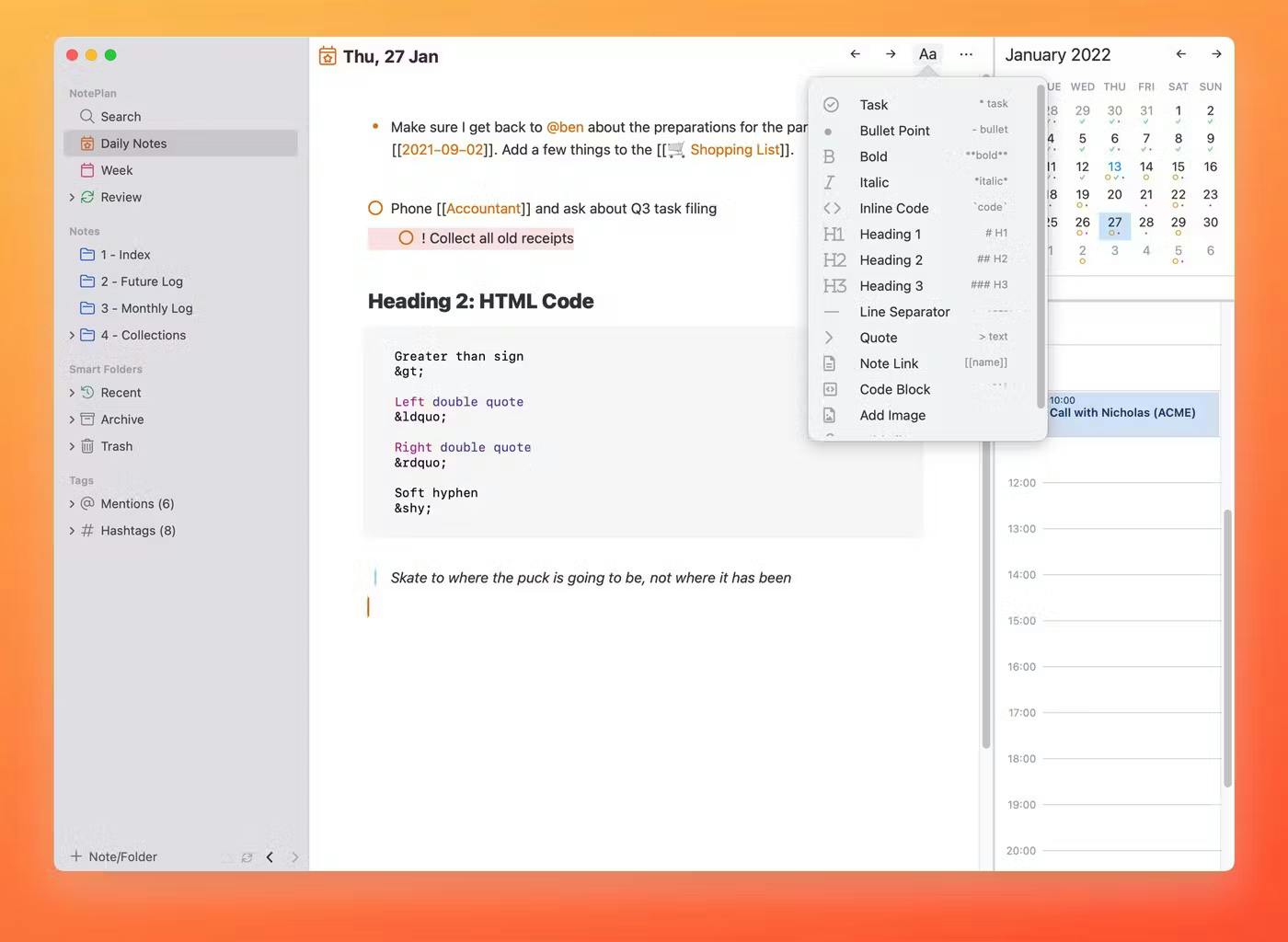
Take your Bullet Journal digital with NotePlan
Get started for free with a 7 day trial
Managing Tasks
NotePlan enhances task management. You can quickly shift tasks around, schedule repeating tasks, and use #tags or @mentions for tasks for easy reference. They've also streamlined how tasks are organised in a note by putting completed, canceled, or moved tasks under their respective headings. This declutters your to-do list, leaving you with the tasks that still need to be done. In a paper system, tasks may be scattered around on different pages.
Notes, Collections, and Linking
While a physical Bullet Journal helps structure information, NotePlan goes a step further by making the connection between tasks, notes, and ideas a breeze. Using [[, you can create links to other notes, facilitating easy referencing and follow-ups. Interestingly, NotePlan features bi-directional linking, creating reciprocal links in the original and targeted notes. This feature can be used to craft your personalised PKM (Personal Knowledge Management) system, a Zettelkasten structure, or a second brain.
Searching and Filtering
Searching and filtering notes in NotePlan is effortless. It boasts a swift search mechanism that scans all content. You could save custom searches regarding tasks, notes, or keywords. Need a list of all tasks marked #urgent or a summary of 'postmodernism' usage throughout your notes? NotePlan's custom search has got you covered.
Revisions, Backups, and Sync
NotePlan was built to give you the peace of mind that all of your notes are safe. It comes with an efficient revisions and backup system. It lets you revisit any former version of your notes while neatly archiving the change history. With notes synchronization in NotePlan, you can switch seamlessly between your desktop and mobile.
Pros of NotePlan
- Adapts to various journaling styles and structures.
- Enhances the connectivity of information and efficiency of task tracking with advanced Linking and Task Management
- Offers powerful search tools and seamless synchronization across devices.
- Features comprehensive backup and revision systems for data integrity.
Cons of NotePlan
- Although popular, Markdown syntax might require an initial learning.
- Not available for Android users.
Take your Bullet Journal digital with NotePlan
Get started for free with a 7 day trial
Trello
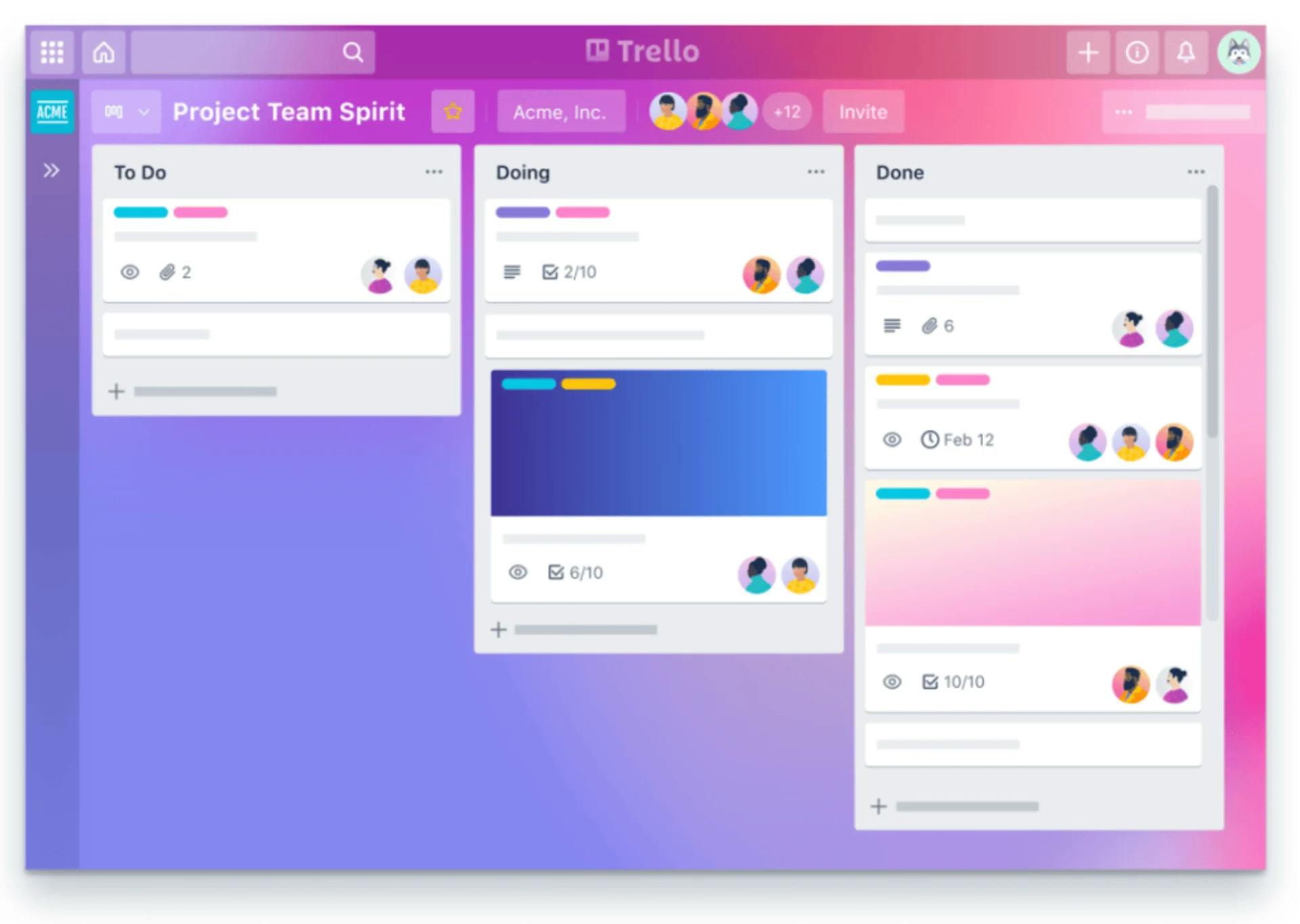
Trello is an adaptable project management tool that can be effectively utilized for bullet journaling, offering a digital and highly customizable platform for organizing tasks, notes, and projects.
Bullet journal enthusiasts can take advantage of Trello's board and card system, where each board can represent a journal, and cards within these boards can serve as entries. Users can categorize these cards under lists, which might represent daily, weekly, or monthly logs, as well as different themes such as tasks, events, or notes
One of the standout features for bullet journaling in Trello is the ability to add due dates, checklists, and labels to cards, which helps in tracking the completion of tasks and organizing them by priority or category. Attachments and links can be added directly to cards, making it easy to keep all related information in one place.
Ratings & Reviews:
- App Store: 4.4 out of 5
- Google Play: 4.3 out of 5
Pricing:
Free plan. Paid Plan starting with $6/mo standard plan.
Pros of Trello:
- Boosts collaboration and creativity in bullet journaling.
- Provides customization options including background photos and stickers.
- Features easy personalization of cards with images or labels.
- Encourages structured thinking with organized weekly lists.
- Allows attachments to cards for a comprehensive view.
- Promotes efficiency with collaboration, automation, and backup features.
- Enables separate boards for each month for focus and clarity.
Cons of Trello:
- Trello's extensive customizability can lead to cluttered boards and may overwhelm users if content isn't routinely organized.
- If you're without a reliable Internet connection, Trello loses some functionality.
- Having a limited number of boards on Trello's free version restricts multiple-board users.
- Trello is missing certain crucial bullet journaling features like a seamless integration of daily, monthly, and yearly logs, an index, and a future log.
Taskade
Taskade is a versatile tool designed to simplify project management and note-taking, making it a suitable choice for bullet journaling. This platform offers a streamlined approach where users can create projects that function similarly to bullet journals. Within each project, tasks and notes can be organized into nested lists, which can be toggled to view as a checklist, mind map, or even a calendar. This flexibility allows bullet journal enthusiasts to structure their entries in a way that best suits their workflow.
With the plethora of bullet formats, basic formatting options, and emojis, personalizing your digital journal is fun and easy. Plus, included features like Due Date, Add To Calendar, attachments, templates, comments, tags, and search functionality are extremely handy for keeping your tasks and notes organized and accessible. Whether you're a person who likes detailed planning or prefers only key bullet points, you can structure your journal to fit your style.
Ratings & Reviews:
- App Store: 4.7 out of 5
- Google Play: 4.4 out of 5
Pricing:
Free plan. Paid Plan starting with $10/mo pro plan.
Pros of Taskade:
- Taskade has a clean, user-friendly interface that’s easy to navigate.
- Users can switch between different viewing options (list, board, action, mind map) to suit their journaling style.
- The platform enables real-time collaboration, making it easy to share your journal or coordinate with others.
- Taskade is available on multiple platforms, including web, mobile, and desktop applications, ensuring access from anywhere.
- Many of Taskade’s core features are available in the free version, making it accessible without immediate investment.
Cons of Taskade:
- Some users might find the features too basic compared to more specialized journaling or project management tools.
- Taskade doesn’t have a dedicated offline mode, which means you always need an internet connection to access your tasks
- There's also a lack of flexibility in layout options, which may be an issue for those who prefer to customize their bullet journal layout in a certain way
The Bullet Journal Companion 2
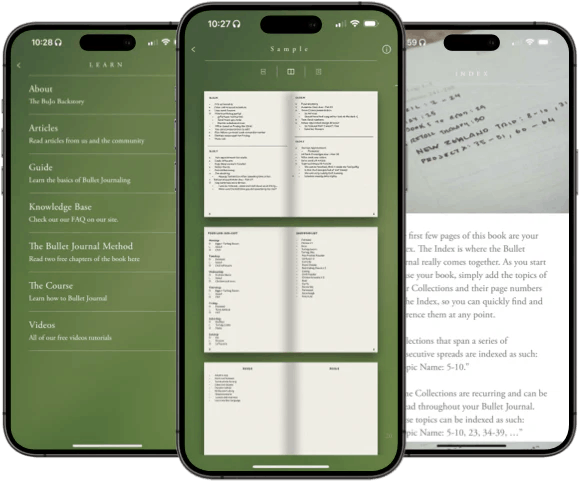
The Bullet Journal Companion 2.0 is an official app designed to complement the traditional paper-based bullet journaling method, created by Ryder Carroll, the founder of the Bullet Journal system. This app is tailored to enhance the analog experience rather than replace it, acting as a support tool for those who prefer to use a physical notebook.
Among the features of The Bullet Journal Companion 2.0, users will find a reflection tool that prompts them to periodically review their entries, ensuring they remain mindful and engaged with their tasks. The app also includes a library section where users can store photos of their bullet journal pages, allowing for easy digital backups and the ability to carry their logs without needing the physical journal at all times. Additionally, the app provides articles, tips, and instructional content directly from Ryder Carroll, which can be incredibly valuable for both new and seasoned practitioners of bullet journaling.
Ratings & Reviews:
- App Store: 4.5 out of 5
- Google Play: 4.6 out of 5
Pricing:
$4.99 purchase from Apple Store
Pros of The Bullet Journal Companion 2:
- Specifically built to support the Bullet Journal system.
- Bridges the gap between digital convenience and the physical journal.
- Allows users to carry a digital backup of their journal.
- Offers tips and articles from the Bullet Journal creator.
Cons of The Bullet Journal Companion 2:
- Primarily designed as a companion rather than a standalone app, it might not offer all the features found in more comprehensive digital planners.
- Unlike many basic apps, it requires a subscription to unlock all features.
- Still necessitates using a physical notebook, which might not appeal to those looking to go completely digital.
- Specifically geared towards users of the Bullet Journal method, which may not cater to everyone's organizational style.
Dynalist
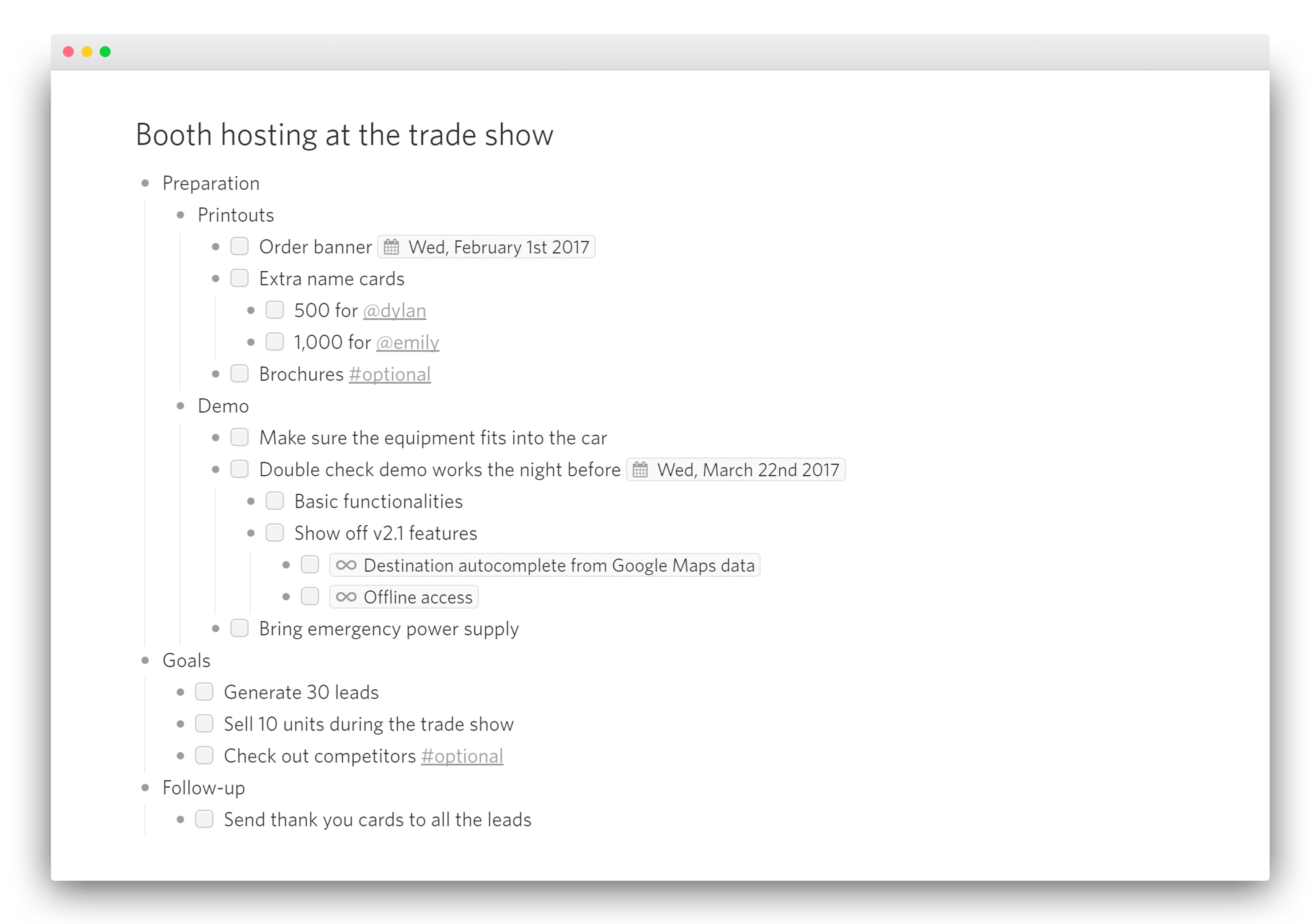
Dynalist is a powerful tool that allows users to organize their thoughts and tasks using a hierarchical list format, making it a versatile platform for bullet journaling. This app excels in structuring information in nested lists, which can expand and collapse, allowing users to manage detailed projects and daily entries efficiently. Users can create documents within Dynalist, each serving as a separate journal or as different components of a journal, such as daily logs, monthly calendars, and future logs.
Dynalist also supports tagging, which makes it easy to categorize and search for specific entries. Each item in a list can have notes added to it, which is particularly useful for adding details without cluttering the main view. The platform includes date tagging with a built-in calendar, reminders, and recurring dates, which can be particularly useful for tracking tasks and appointments within a bullet journal framework.
Ratings & Reviews:
- App Store: 3.9 out of 5
- Google Play: 4.2 out of 5
Pricing:
Free plan. Paid plan starting with $9.99/mo for pro plan.
Pros of Dynalist:
- Offers deep levels of nesting, making it easy to structure and restructure entries.
- Enhances the ability to quickly locate entries through tags and a robust search function.
- Available on multiple devices, ensuring access to your bullet journal anytime and anywhere.
- Keeps your journal updated across all devices, which is convenient for users on the go.
Cons of Dynalist:
- It can be overwhelming for beginners due to the number of features it supports.
- Time and effort needed to understand and effectively utilize all features.
- Lacks some additional capabilities like habit tracking and document scanning.
- Lacks visual tools like drawing or handwriting inputs, which might be a drawback for those who prefer visual elements in their journaling.
Elisi
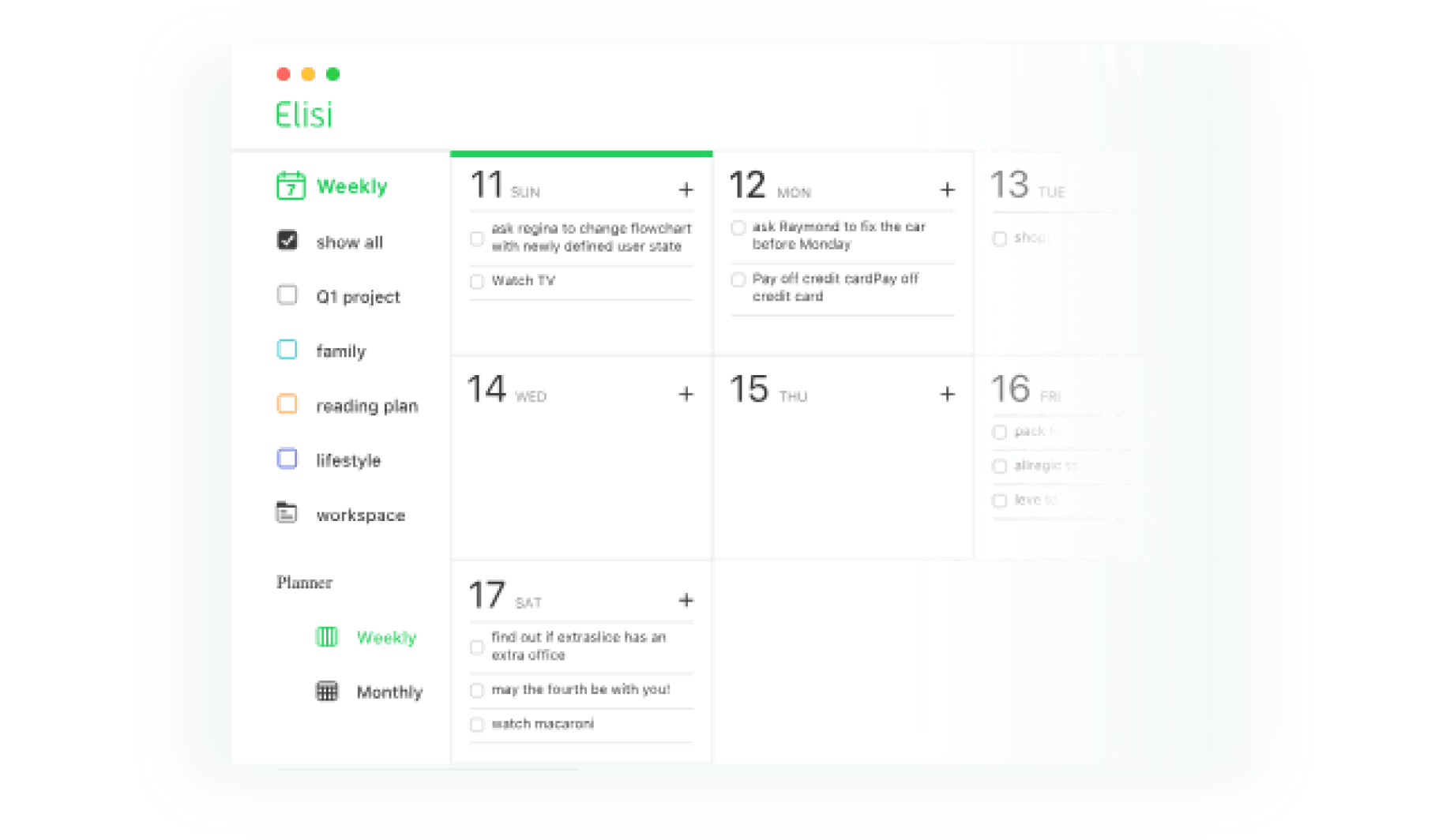
Elisi is a digital planner app that mirrors the flexibility and simplicity of traditional bullet journaling, making it an appealing choice for those looking to maintain an organized life digitally. The app is designed to help users track their weekly tasks, habits, and personal goals seamlessly across all devices. Elisi allows users to quickly set up and manage different aspects of their lives such as tasks, notes, projects, and appointments, all from one interface.
A notable feature of Elisi is its intuitive design, which simplifies the process of planning and tracking daily activities. The app includes a habit tracker that encourages users to develop and maintain good habits by providing visual feedback on their progress. Additionally, Elisi offers a notes section where users can jot down ideas and reflections, integrating the practice of journaling into daily life. The app’s ability to sync across multiple devices ensures that users have access to their bullet journal anytime and anywhere, enhancing productivity and continuity in planning.
Ratings & Reviews:
- App Store: 4.4 out of 5
- Google Play: 3.7 out of 5
Pricing:
Download for free
Pros of Elisi:
- Easy to use, making it accessible for beginners in digital journaling.
- Promotes consistency and personal growth by tracking habits.
- Accessible on multiple devices, providing flexibility and convenience.
- Offers a visually appealing interface that makes planning enjoyable.
Cons of Elisi:
- Lack of offline mode, requiring constant internet access for use.
- Elisi’s task management features might seem basic as compared to other tools
- Might not offer as comprehensive features as some other specialized planning tools, which could be a limitation for power users.
- Limitations on exporting data from Elisi to other formats or platforms, making it less flexible
- Offers limited options for personalization in terms of themes, colors, and layout adjustments
Journey
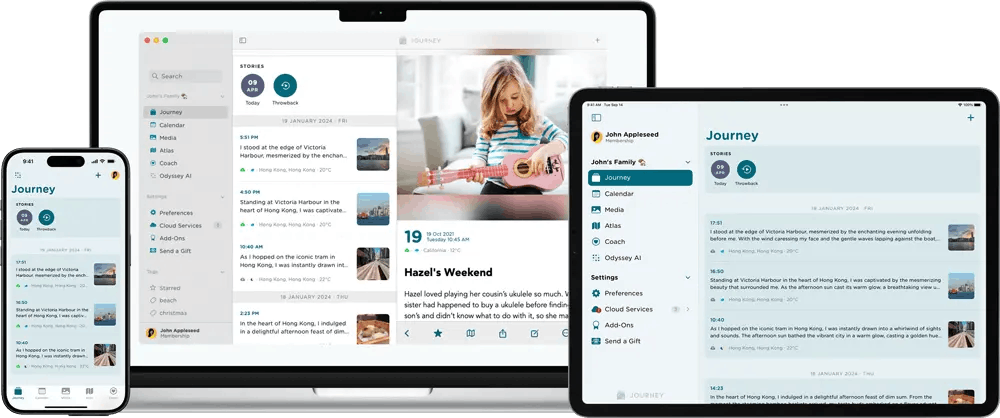
Offering both web and mobile applications, Journey combines simplicity with versatility. This app has a primary focus on journaling and reflection, fostering a daily habit of mindfulness and introspection. But don't let its simplicity fool you. From the ability to sort entries through tags to effortless syncing across devices, Journey incorporates everything you'd desire in a bullet journaling tool while building in plenty of useful bells and whistles.
Ratings & Reviews:
- App Store: 4.3 out of 5
- Google Play: 4.4 out of 5
Pricing:
$4.17/mo billed annually, cancel anytime.
Pros of Journey:
- Works seamlessly across Android, iOS, Windows, and web platforms, ensuring accessibility from any device.
- Offers strong security measures like passcode and fingerprint locking to keep journal entries private.
- Supports inclusion of photos, videos, and audio clips in entries, making the journaling experience rich and memorable.
- Promotes well-being through mood tracking and reflective prompts.
Cons of Journey:
- Features like markdown, night mode and PDF export, you’ll have to shell out for the Premium version.
- Lacks advanced task management features that are typical in dedicated bullet journaling and productivity apps.
- Does not support sharing or collaborative features, which might be a drawback for users who wish to share their journals or collaborate on projects.
- Offers fewer customization options in terms of layout and template designs compared to more specialized bullet journaling apps.
Day One

Day One is more than just a bullet journaling app; it's a multimedia journaling platform that integrates photo, video, and audio recordings, alongside traditional text entries. The platform is highly intuitive, making it easy for you to note down goals, tasks, or reflections with only a couple of clicks. Its most notable attribute is the ability to sync entries across multiple devices, a feature both iOS and Android users will appreciate.
The app also includes a feature called "On This Day," which provides users with an opportunity to revisit past entries, enhancing the reflective aspect of journaling. Moreover, the Day One app supports multiple journals and offers numerous options for organizing and categorizing entries.
Ratings & Reviews:
- App Store: 4.8 out of 5
- Google Play: 4.7 out of 5
Pricing:
Free plan. Paid plan available annually at $34.99.
Pros of Day One
- Offers a visually appealing and easy-to-navigate interface.
- Allows inclusion of various media types like photos, videos, and audio.
- Integrates with Apple Health and other services for automatic entry updates.
- Features end-to-end encryption for user privacy.
Cons of Day One
- While the app does offer a free plan, it is relatively limited, restricting some of the platform's main features such as syncing.
- Primarily designed for iOS and macOS, which limits accessibility for users on other platforms.
- While highly effective for personal journaling, it might lack specific features tailored to task management and project tracking that other bullet journaling apps offer.
- Does not support collaborative features, which makes it less suitable for team use or shared journaling experiences.
Grid Diary
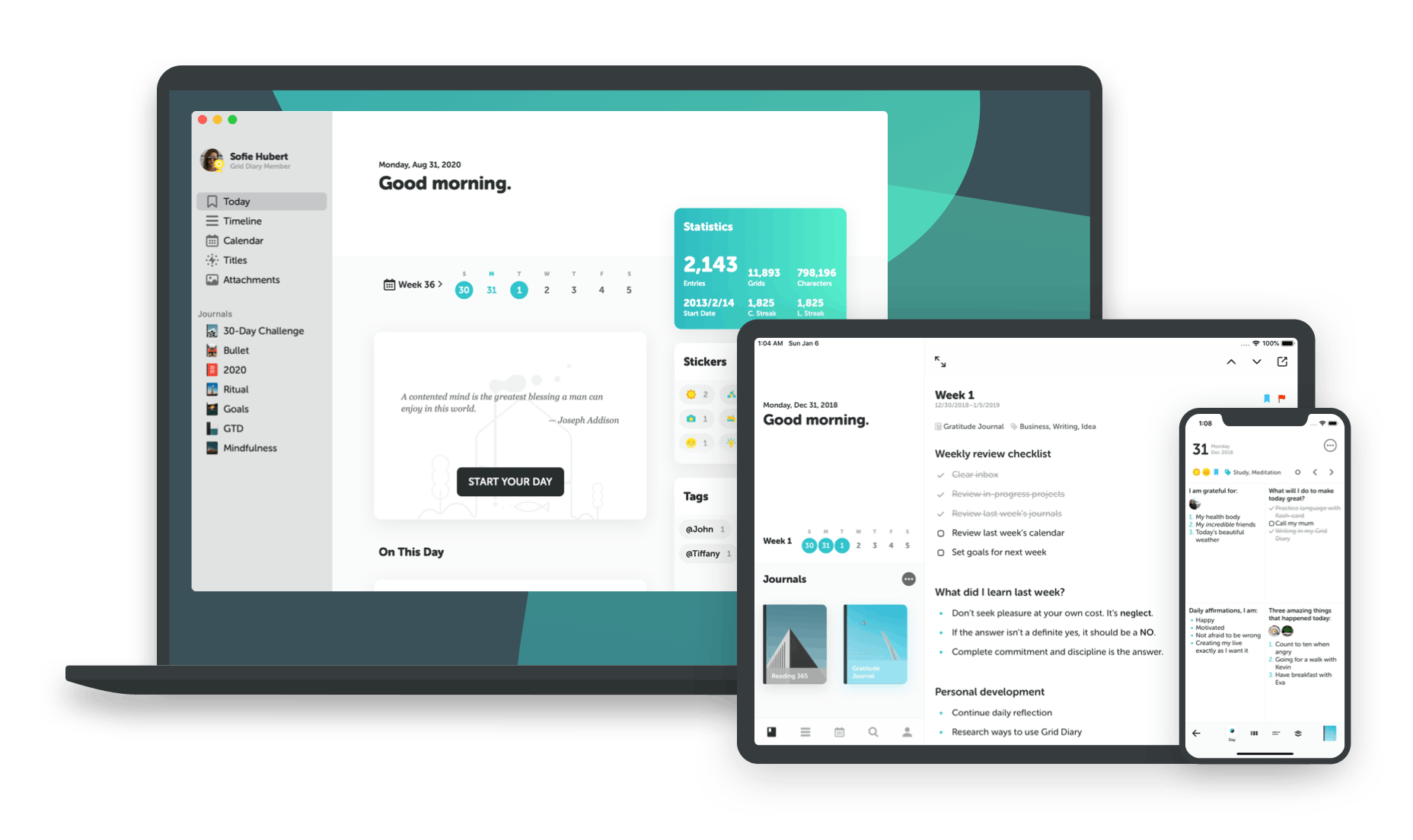
Grid Diary is a journaling app designed with a unique grid format that encourages structured yet flexible entry creation, making it suitable for bullet journaling. The app allows users to customize their journal layout by selecting and arranging question prompts, which guide the journaling process and facilitate reflection and planning. This structured approach helps users focus on specific aspects of their lives, such as personal growth, daily activities, or health tracking.
The app's interface integrates a calendar view, making it easy to navigate between past and future entries. Users can also set reminders to write in their journal, helping establish and maintain a consistent journaling routine. Grid Diary supports the inclusion of photos and location tagging in entries, adding a rich, personal context to the recorded moments.
Ratings & Reviews:
- App Store: 4.8 out of 5
- Google Play: 4.1 out of 5
Pricing:
Free plan. Paid plan starting with $2.99/mo.
Pros of Grid Diary:
- Its structure focuses on reflective questions, facilitating in-depth self-analysis and fostering greater self-awareness.
- It is customizable to cater to your personal needs and preferences.
- Its versatility allows it to be used for various applications, from daily activities and task scheduling to productivity optimization and emotional journaling.
- It features an aesthetically pleasing interface that provides a tranquil journaling experience.
- It includes weather and mood tracking features and integrates with Apple Health, allowing you to monitor wellness and productivity in one place.
Cons of Grid Diary:
- While the layout is customizable, there are fewer options for aesthetic personalization compared to other apps.
- Lacks extensive multimedia integration, which can be a drawback for users who prefer to include a variety of media types in their entries.
- The structured question format might not appeal to users who prefer a more free-form approach to journaling.
OneNote

Microsoft OneNote, a note taking tool, offers a wide array of features that help you keep track of ideas, to-dos, and professionally relevant information.
OneNote's features align well with the fundamentals of bullet journaling. It allows you to create separate notebooks for different areas of your life or projects, with the ability to further divide these into sections and pages for a high level of organization. In addition, you can easily create and manage to-do lists by using clickable checkboxes, a feature that replicates the rapid logging aspect of bullet journaling.
One significant advantage of OneNote is its inking capability, which allows you to take handwritten notes or draw directly on the screen, provided you are using a device with touch-screen capabilities. This appeals to those who enjoy the traditional way of keeping a journal or wish to add a personal touch to their entries.
Ratings & Reviews:
- App Store: 4.7 out of 5
- Google Play: 4.7 out of 5
Pricing:
OneNote is available with a paid subscription of Microsoft 365.
Pros of OneNote
- Freedom to arrange and organize notes like a digital notebook.
- Availability across all devices, ensuring that your journal is always at your fingertips.
- In-depth note-taking features, including the ability to embed videos, voice notes, and files.
- Powerful search function which can scan text within images and handwritten notes.
- In-build templates and the ability to create custom ones for regular journal entries.
Cons of OneNote
- The lack of a tagging feature for individual notes within a page might be a setback if you heavily rely on tags for organizing your notes.
- There's a learning curve to OneNote's full features, which can be time-consuming initially.
- The search functionality can often be relatively slow and frustrating when compared to alternatives.
- Does not have specific bullet journaling features like pre-made templates or an index, requiring users to set up their system manually.
Evernote
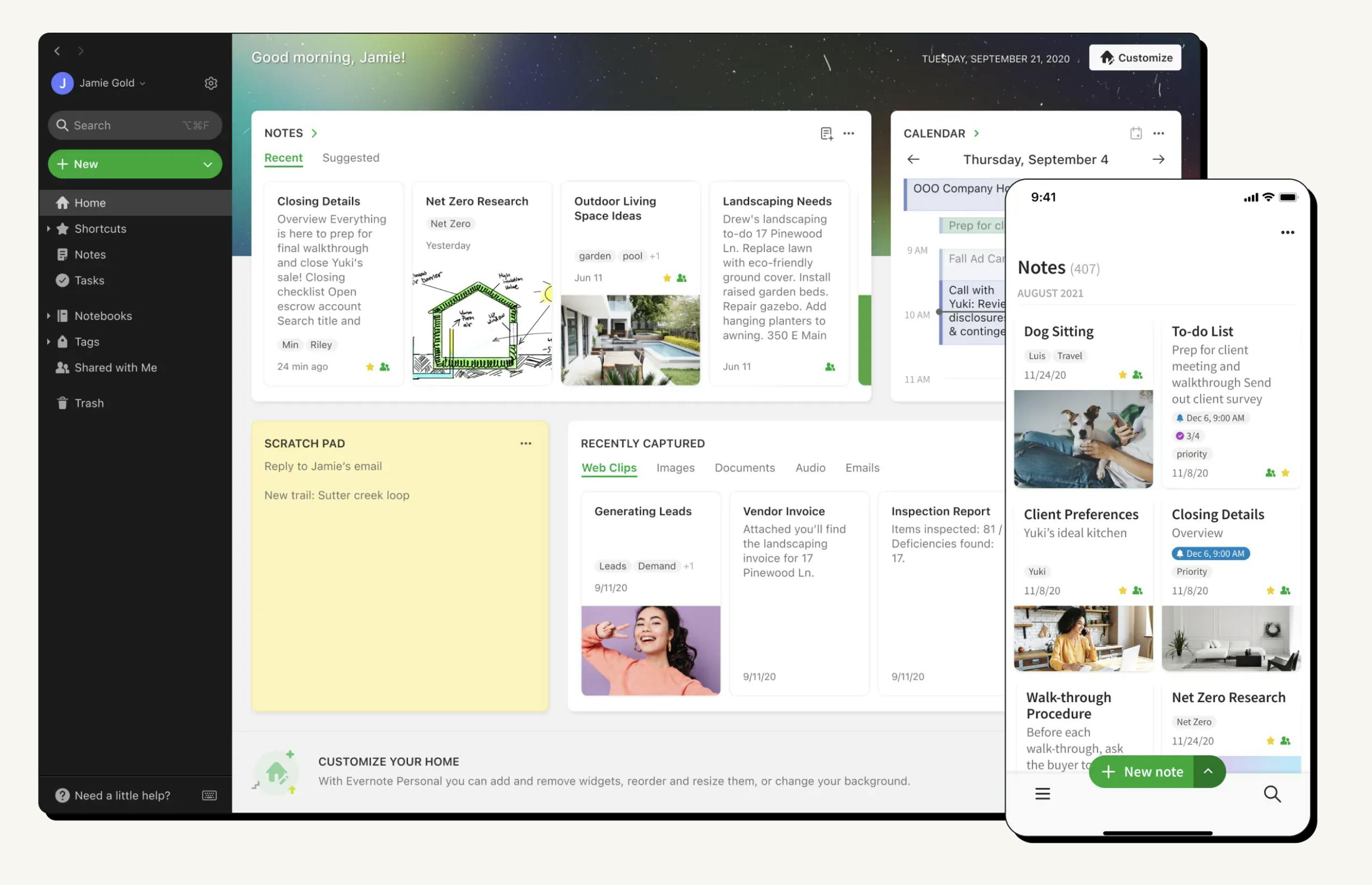
Evernote is a popular note-taking application that also serves as an effective tool for bullet journaling. Users can create different notebooks within Evernote, each potentially serving as a separate journal or as different components of a bullet journal like collections, monthly logs, or daily entries. Evernote supports text, images, audio recordings, and attachments, allowing users to enrich their journal entries with multimedia content.
One of Evernote’s key features is its powerful search functionality, which enables users to quickly find notes by searching for text, even within images. This is particularly useful for bullet journalers who need to retrieve information quickly. The application also offers templates for various types of planning and note-taking, which can simplify setting up a new bullet journal. Evernote’s ability to sync across all devices where it's installed ensures that users have access to their journals whether on a phone, tablet, or computer.
Ratings & Reviews:
- App Store: 4.4 out of 5
- Google Play: 3.9 out of 5
Pricing: Free, starting with $14.99/mo personal plan
Pros of Evernote:
- Notebooks, tags, and stacks help keep journal entries well-organized.
- Enables inclusion of various media types in journal entries.
- Advanced search features make retrieving information quick and easy.
- Available on multiple operating systems and devices for easy access anywhere.
Cons of Evernote:
- Evernote lacks a built-in calendar function. For those who heavily rely on calendar integrations in their bullet journaling, it can be a hindrance.
- While it offers good archive and retrieval capacities, the user interface is often reported as somewhat cluttered and not as intuitive compared to other platforms.
- The lack of offline functionality for free users can be a disadvantage for those who often work without reliable internet access.
- Improved tagging functionality, crucial for organization in bullet journaling, is only available in premium versions.
Conclusion
In wrapping up, it's clear that each bullet journaling software we discussed offers unique ways to enhance productivity and streamline workflow.
Choosing the right tool ultimately boils down your personal needs, workflow, and how each software resonates with you. It's productive to try a few options to grasp the ones that truly cater to your needs.
With a perfect mix of utility and customization, giving NotePlan a try would certainly enrich your journey through the vast landscape of digital bullet journaling.
Can one app really replace your entire productivity stack?
NotePlan did. Try NotePlan free for 7 days to learn how